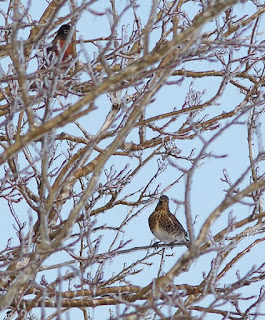The second last day of February found me doing the Avalon Loop in family style = partial birding/partial Sunday drive. Being a cold windy day I had a good excuse not to get out at some of the places you are obligated to get out at when birding The Loop like Pt La Haye and St. Shotts point. It was not the kind of day I expected to have any luck with photography but in the end I got my best photos ever of adult male Common Eider and White-winged Scoter.
Newfoundland Common Eiders are wary. Especially the old adult males. They are the least likely age/sex classification to give a photographer a lucky break and let you take their pictures. All day there were scattered little groups of eiders feeding in close to shore away from the main flocking areas and this included a high proportion of adult males. Driving back from St Shotts point I noted four adult males feeding off the rocks by the road a little closer to shore than normal. The light was good so I decided to try for a picture out the window. My 1.4x converter was in the trunk so I reached for the 2x converter and attached it to the 600 mm f4. Every time I use the 2x converter it is an experiment. Usually there is not enough light or it is too windy or there is some other reason not to even think about using a 2x converter. 1200 mm worth of power attached to the camera sounds like a dream but in reality the 2x more than doubles your headaches trying to get crisp photos. I rarely use it.
Waited for the eiders to dive before moving in as close as I could get in the car. When the closest eider came up it swam even closer to shore before diving again only to resurface even closer. The camera started firing away. But not for long. The eider started looking up at something. I couldn't see what it was, maybe it was an eagle, hopefully not a Gyr(!). The eider and nearby Long-tailed Ducks all went to wing. I was ready with the camera and as the drake eider flew. In a matter of a minute or two the photo session was over. I was pleasantly surprised with the results. Closer examination on computer later showed the majority of the shots were out of focus due to movement of the duck on the choppy water but the pictures that were sharp were the best adult drake Common Eiders shots that I have taken. Even some flight shots came out.
A drake Common Eider in relaxed mode at St. Shotts, Newfoundland on 28 Feb 2016. This is a typical example of drake borealis, the Arctic breeding subspecies which forms the bulk of the wintering population in Newfoundland. The narrow, pointed rich yellowish frontal lobes are characteristic. The more southern dresseri has thicker frontal lobes with broad rounded ends of a more greenish colour.
The eider spots danger overhead. I did not see what it was that flushed this eider and Long-tailed Ducks from the shoreline area.
On full alert with neck stretched high just before flushing.
The flying drake borealis Common Eider.
---------------------------------------------------------------------
The under appreciated adult drake White-winged Scoter is shy like adult Common Eiders. This one had an injured right wing which explains the unusual closeness to shore in Biscay Bay and the large amount of white showing in the wing while at rest. The finer details of the bill colouring are difficult to see at the usual range at which we view White-winged Scoters. The shape of the white eye mark, curved like the Detroit Redwings emblem, is used by Europeans when looking for White-winged Scoters among the very similar Velvet Scoter of Europe.
--------------------------------------------------------------------------
A female Common Eider beats some of the legs off a small crab before swallowing. Adult female Common Eiders usually have white wing bars and are often a bright orange-brown colour but range all the way to grayish-brown.






















































